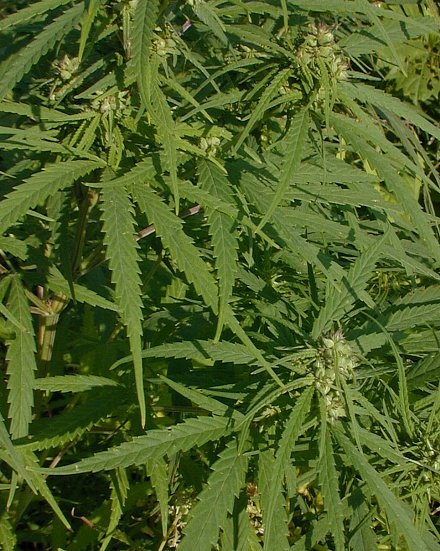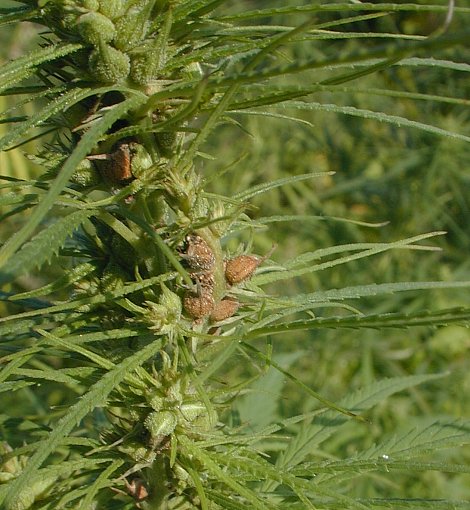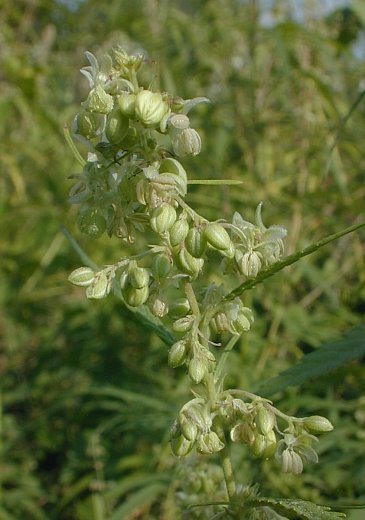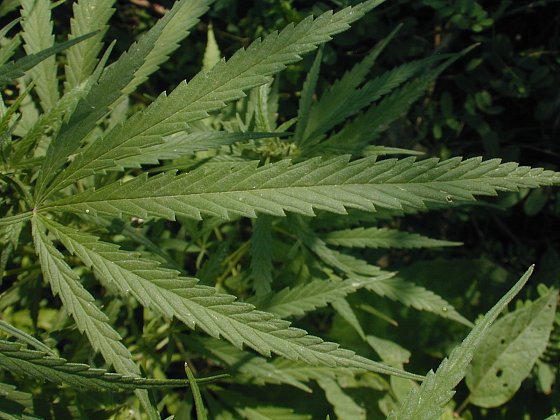Description: This plant is a summer annual about 3-9' tall. It is unbranched or little branched. The stout central stem is light green; where new growth occurs, this stem is more or less pubescent, but it becomes less hairy with age. The lower leaves are often opposite, while the upper leaves are alternate. These leaves are palmately compound with 3-9 leaflets (usually there are 5-7 leaflets). On large plants, these leaves can span up to 10" long and across (excluding the petioles), but they are half this size on smaller plants. While the lower leaves have long slender petioles, the upper leaves are nearly sessile. These petioles are more or less pubescent and occasionally reddish green. Each leaflet is narrowly ovate and coarsely serrated along the margins; the middle leaflets are larger in size than the lateral leaflets. The upper surface of each leaflet is dark green and sparsely pubescent.

Hemp is dioecious with both male and female plants. The male plants produce both axillary and terminal panicles of male flowers. These panicles are up to 1' long; they have small leafy bracts and pubescent stalks. Each male flower is about 1/8" (3 mm.) across, consisting of 5 sepals, 5 stamens with large anthers, and no petals. The oblong or lanceolate sepals are initially green, but they become cream or pale yellow with maturity. After these flowers have shed their pollen, the foliage of the male plant soon turns yellow and withers away. The female plants produce short axillary spikes of female flowers; these spikes are about 1" long and covered with glandular hairs. Each female flower is about 1/8" (3 mm.) long, consisting of a single sepal, an ovary with two styles, and no petals. The sepal wraps around the ovary, forming a beak at its apex; the 2 styles are exerted from this beak. The surface of the sepal is green and covered with glandular hairs that exude a characteristic odor when they are rubbed. At the base of each female flower, there is a single green bract that is lanceolate and longer than the flower. There are small leaves and other bracts along the spike as well.

The blooming
period occurs from mid-summer to early fall and lasts about 1-2 months.
Pollination is by agency of the wind. Upon maturity, the female flowers
turn brown, but the foliage of female plants remains green until the
fall. Each female flower is replaced by an achene containing a single
large seed. The root system consists of a branched taproot. This plant
often forms colonies at favorable sites.
Cultivation:
The preference is full sun, moist conditions, and a fertile loamy soil.
Mesic conditions and other kinds of soil are also tolerated, but the
size of plants will be smaller. Hemp is little bothered by pests and
disease. It tolerates occasional flooding.

Range &
Habitat:
Hemp occurs occasionally in central and northern Illinois, while in the
southern portion of the state it is uncommon or absent (see Distribution
Map). Hemp is native to central Asia and it was introduced to
the United States for agricultural purposes. Habitats include borders
of floodplain woodlands, borders of low-lying fields, weedy meadows
along rivers, fence rows, and roadside ditches. Occasionally, it is
cultivated illegally in backyards and fields. This plant is found
primarily in disturbed habitats.
Faunal Associations:
There is little information about floral-faunal relationships for Hemp.
The wind-pollinated flowers don't attract many insect pollinators.
Mammalian herbivores avoid browsing on hemp when other plants are
available.
Photographic Location:
A roadside ditch in Champaign, Illinois.

Comments: Hemp has been cultivated in the United States since colonial times. The fibers of the central stem are quite strong; they have been used in making rope, paper, clothing, and other products. The foliage, flowers, and seeds of female plants contain chemicals with medicinal and recreational properties. However, since World War II, it has been illegal in Illinois and other areas of the United States to cultivate hemp. The industrial form of this plant is Cannabis sativa sativa (Hemp), while the medicinal and recreational form is Cannabis sativa indica (Marijuana). It is usually the industrial form of this plant that is encountered in the wild; it has a more robust habit of growth and contains lower levels of chemicals with medicinal and recreational properties. Hemp has a unique appearance and is easy to distinguish from other species of plants. A small specimen of Hemp superficially resembles some Potentilla spp. (Cinquefoils), especially Potentilla recta (Sulfur Cinquefoil), because of the similarity of their palmate leaves. However, the leaflets of Hemp are more elongated and tapered at their tips than Sulfur Cinquefoil. Furthermore, the flowers of Cinquefoils have 5 conspicuous petals that are white or yellow, like many other members of the Rose family, while the flowers of Hemp are devoid of petals.